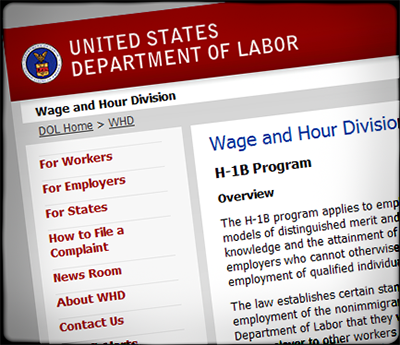
Twice within a period of a few days the administration has announced initiatives to rein in the once invincible H-1B program for college grad foreign workers.
In one of these moves, the president ordered that the government as an employer should give priority to U.S. citizens and green card holders over H-1Bs on the government's own payroll, as we previously reported.
In the other, the Department of Labor, as a regulator, announced an agreement with the Department of Homeland Security that the latter would provide DoL with data on potentially suspect activities within the H-1B program that it had in its own files, but had never shared with DoL in the past.
Of the two announcements, the first got more attention and the president's signature, while the second has much more potential to assist U.S. workers than the first. This is because there may be about 2,000 direct H-1B hires in the federal government, but something like 600,000 H-1B workers employed by the private sector and other levels of government that will now be subject to greater regulatory scrutiny. The arrangement is in the form of a memorandum of agreement signed by the two agencies, and described in the DoL press release as follows:
[T]he MOA establishes processes by which USCIS will refer suspected employer violations within the H-1B program to the Department of Labor that USCIS identifies in the course of adjudicating petitions — a source of information never previously accessed by the Department for enforcement purposes — and conducting administrative and targeted site visits. The enhanced collaboration and sources of information will be used by the Department of Labor in support of Secretary-certified investigations." [Emphasis added.]
I have no idea what a "Secretary-certified investigation" is, but I do know that there has been a large amount of information held by one agency (USCIS, a subset of DHS) that would be useful to another but not shared with the other (in this case the Department of Labor's Wage and Hour Administration). This is all too typical of a government with too many singled-minded silos (in all policy areas) and too little coordination.
Frankly this is something that should have been sorted out a generation ago, but it is good that it finally has been resolved, at least at the top levels. How much difference this will make depends on executive will on the matter and how thoroughly the two parties use the resources.
As a long-ago alumnus of DoL, having served in the Office of the Secretary during the JFK and LBJ administrations, I sensed that the rank and file wage-hour investigators, as well as the executives in that unit, were gung-ho on making life better for America's workers. It is good that they now will have easier access to the H-1B applications and other records in the USCIS files. I suppose later is better than not at all.
This may not be significant, but there is lopsidedness to the authorized signatures section of the MOA; pp. 14 and 15 of it show it being signed by John Pallasch, assistant secretary of Labor, and by Cheryl Stanton, the Wage and Hour Division administrator, both presidential appointees and both confirmed by the Senate; it is also signed by the Department's acting Inspector General, Larry D. Turner. For DHS it carries a single signature, that of Matthew Gravis, USCIS's chief data officer, presumably a civil servant.
Then again, DoL has many of its top officials confirmed by the Senate, a rarity in DHS.
